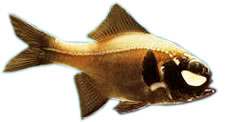
Dimdima
Online Children's Magazine from India

Dimdima
Online Children's Magazine from India



By Rani Iyer

Some of the tiniest creatures in the ocean have amazing powers! Consider the luminescent bacteria. Luminous bacteria are gram-negative and occur in two genera, Vibro and Photobacterium. They move around using flagella. In appearance and physiology, they are close to enteric bacteria that occur in the intestine of man and other mammals. The luminescent bacteria occur in symbiotic relationship with organisms that live in deep sea. Cuttle fish, clams, squid, herring, shrimps, and deep-sea anglerfish have organs in their body in which the luminous bacteria live! Flash light fish possess an organ called light organ, in which the bacteria are closely packed and appears to glow in the dark.
Anomalops, a tropical surface water fish, has a luminescent organ beneath the eye!
The bacteria have the luciferace gene, that is also found in fireflies. Luminescent bacteria are rather rare in land, but scary instances of bacterial growth are reported. A Canadian man who wanted to eat a late night snack of crabs was scared out of his wits when they had a blue-green glow in the dark! Some people living in the seaside report the occurrence of 'glowing wounds'! In this case, the luminescent bacteria infected the wound. Passengers on cruise ships, often report an eerie glow from seawater-flushed lavatories! The bacteria can also grow on dead, dying and decaying fish in the ocean.
Why do bacteria produce light? Scientists are not yet sure. But one of the theories is that when a fish accommodates a glowing bacteria, it gets light and the bacteria gets more oxygen than by living in the sea floor. This helps the fish to spot food easily in the forest floor. Such mutual help in a relationship is called 'symbiosis'. The blue-green light produced by marine organisms has evolved due to two reasons. First, blue-green light (wavelength around 470 nm) transmits furthest in water. Second, most organisms are sensitive only to blue light. They lack the visual pigments, which can absorb longer (yellow, red) or shorter (indigo, ultraviolet) wavelengths.
Even among deep-sea fish, there are exceptions to the rule. In the Loose jaws family (Malacosteid), the fish produce only red light. These are not visible to other organisms. The light produced by species of Malacosteus, Aristostomias, and Pachystomias is nearly infrared. Aristostomias has more than one light organ, a red one to spot the prey, and a blue-green one to communicate with others!
Luminescent bacteria occur in oceans of all regions: the Indian, the Atlantic and the Pacific Oceans, of the Black, Mediterranean and other seas, from tropical to polar latitudes and from the surface layers to the depth of several thousand meters.
Next time you visit the seashore, take some time to observe the cuttle bones, clams and other objects that wash to the shore. You might make a new discovery!
Last updated on :11/24/2003
EXPLORE MORE...
COMMENT ON THIS ARTICLE
Wants to share something related to this article? Please use the form below.
Dimdima is the Sanskrit word for ‘drumbeat’. In olden days, victory in battle was heralded by the beat of drums or any important news to be conveyed to the people used to be accompanied with drumbeats.
Bharatiya Vidya Bhavan
K. M Munshi Marg,
Chowpatty, Mumbai - 400 007
email : editor@dimdima.com
Bharatiya Vidya Bhavan
505, Sane Guruji Marg,
Tardeo, Mumbai - 400 034
email : promo@dimdima.com
Dimdima.com, the Children's Website of Bharatiya Vidya Bhavan launched in 2000 and came out with a Printed version of Dimdima Magazine in 2004. At present the Printed Version have more than 35,000 subscribers from India and Abroad.